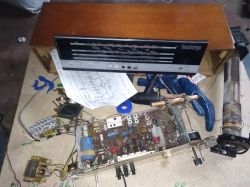pawelr98 wrote: a2b wrote: .
And I am old and I remember how it was when there was nothing and in order to buy what you are restoring now you had to stand in queues or you had to have connections, And you could see the western class equipment in pewex (https://pl.wikipedia.org/wiki/Pewex)
That is why memories of those times irritate me
Greetings
.
I would scrap at most these car-like products.
Fiats and Polonezes.
My grandparents had equipment from Pewex and other things downloaded through side channels.
A Japanese TV from Pewex after more than 20 years was given to the hospital because it was bought LCD. An '88 Sanyo VCR bought at a bazaar (for the price of a car) I recently took apart myself, keeping the clock and date control electronics fully operational.
Whoever had the money could buy one anyway.
My grandfather and grandmother were engineers. And they were able to do it all without party history.
Grandfather himself refused an offer to join the party in exchange for the position of director. I even have documents somewhere stating his lack of political involvement on one side or the other (an opinion written down by some party apparatchik).
However, you have to give credit to the electronics of the period for being durable.
I know that the commune was a shambles. I have heard enough from my grandparents and parents and I am a little interested in the history of technology, but...
The biggest foolishness that I can not understand was to buy a new baby car for vouchers or vouchers waiting for it for years and the curiosity of its price which increased by a crore after driving on the street from Polmozbytu , today we would all be rich if it was

Colour TV Elektron or earlier Rubin was bought at the train station just after the arrival of the train from the eastern border of course for thick money with zero guarantee.
Washing machine, etc. you could stand in line for 3 days and still did not get because just two arrived at the shop of which the shop manager had friends and needed three and even so would take more because he sold them at his garage .
Battery for the car ........no yes what car Syrena, Trabant maybe Wartburg ... battery was not there you had to give your own to regeneration or stand your own - a disaster .It was cool remember Baterwit miracle cure for an old battery
It could be written about for several pages.
Your grandparents were certainly persecuted and their lives were made difficult, but I fully respect their attitude.
Their attitude was the result of education and a clear view of the situation.
It's true that electronics are durable, but do they hold up?
In my line of business most of the devices, maybe not that old but, let's say, from the 90s, well made and durable are no longer suitable for anything if they do not have enough memory, they are too slow, they are based on older solutions.
Please, pay attention while watching an American film from, say, the 60s, in every house there is a telephone, pay attention to kitchen equipment, cookers, dishwashers, food processors, coffee machines, etc., where were we then?
Greetings
.






